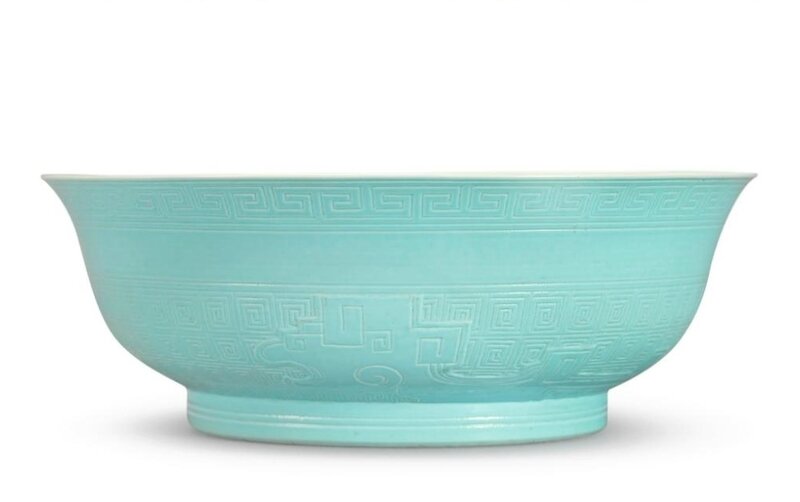A rare carved pale turquoise-enameled 'kuilong' bowl, Yongzheng mark and period (1723-1735)
Lot 8. A rare carved pale turquoise-enameled 'kuilong' bowl, Yongzheng mark and period (1723-1735). Diameter 6 in., 15.2 cm. Estimate 50,000 — 70,000 USD. Lot sold 275,000 USD. Photo: Sotheby's.
well potted with deep rounded sides rising from a slightly tapered foot to a flared rim, finely carved around the exterior with an archaistic bronze design of two highly stylized dragons in shallow relief on a ground of incised leiwen, below a plain band and a keyfret border at the rim, all above a double fillet encircling the foot, covered with an attractive opaque turquoise enamel, the interior and base reserved in white, six-character mark in underglaze blue.
Provenance: Collection of Donald L. Ballantyne (1895-1974), acquired in Asia prior to 1942, and thence by descent.
Note: During the Qing dynasty, archaic bronze forms and designs were an important source of inspiration in the production of imperial porcelain. Occasionally, as with the present example, archaistic designs on porcelain appear on shapes and styles that are otherwise completely unrelated to early bronze vessels. Archaistic dragon forms are here stylized to such a degree that they are recognizable mainly through the accompanying leiwen background pattern, which unmistakably refers to archaic bronze decoration.
Only a relatively small numbers of bowls of this type are known. Compare a closely related example in the collection of Brian McElney, included in the Min Chiu Society exhibition Monochrome Ceramics of the Ming and Ch’ing Dynasties, Hong Kong Museum of Art, Hong Kong, 1977, cat. no. 53. See also a bowl sold in our London rooms, 9th July 1974, lot 345; and another, from the Meiyintang Collection, included in the exhibition Evolution to Perfection. Chinese Ceramics from the Meiyintang Collection/Evolution vers la perfection. Céramiques de Chine de la Collection Meiyintang, Sporting d’Hiver, Monte Carlo, 1996, cat. no. 193 and illustrated in Regina Krahl, Chinese Ceramics from the Meiyintang Collection, London, 1994-2010, vol. 2, no. 911, and sold in our Hong Kong rooms, 9th October 2012, lot 9; a further bowl was sold twice at Christie’s, first in London, 3rd December 1973, lot 339, and then in Hong Kong, 30th November 2011, lot 2928, and is also illustrated in Anthony du Boulay, Christie’s Pictorial History of Chinese Art, Oxford, 1984, p. 222, fig. 6; and another, from the Yiqingge Collection, was sold at Christie's Hong Kong, 29th May 2013, lot 2021.
A fine and very rare carved archaistic turquoise-enameled bowl, Yongzheng six-character mark within double circles mark and of the period (1723-1735), 7/8 in. (15 cm.) diam. Sold for HKD 5,540,000 at Christie's Hong Kong, 30th November 2011, lot 2928. © Christie's Images Ltd 2011
A very rare carved turquoise-enameled bowl, Yongzheng six-character mark within double circles mark and of the period (1723-1735), 5 7/8 in. (14.9 cm.) diam, from the Yiqingge Collection. Sold for 1,590,000 at Christie's Hong Kong, 29th May 2013, lot 2021. © Christie's Images Ltd 2013
Compare also a larger bowl with incised leiwen only under a similar pastel-turquoise enamel, also of Yongzheng mark and period, in the Palace Museum, Beijing, illustrated in Geng Baochang, ed., Gugong Bowuyuan cang Qingdai yuyao ciqi [Porcelains from the Qing dynasty imperial kilns in the Palace Museum collection], Beijing, 2005, vol. I, part 2, pl. 211.
The present bowls were acquired by Donald L. Ballantyne (1895-1974), who worked for Chase Bank in Asia in the early 20th century and is known to have lived in Tianjin, Beijing and Hong Kong, where the present bowls were likely acquired. He and his family returned to the US in 1942 following the Japanese invasion of Hong Kong, and the bowls have remained with the family ever since.
Sotheby's. Important Chinese Art, New York, 13 Sep 2017, 10:00 AM

/https%3A%2F%2Fprofilepics.canalblog.com%2Fprofilepics%2F1%2F0%2F100183.jpg)
/https%3A%2F%2Fstorage.canalblog.com%2F03%2F02%2F119589%2F96711876_o.jpg)
/https%3A%2F%2Fstorage.canalblog.com%2F11%2F31%2F119589%2F94773502_o.jpg)
/https%3A%2F%2Fstorage.canalblog.com%2F20%2F83%2F119589%2F94772815_o.jpg)
/https%3A%2F%2Fstorage.canalblog.com%2F26%2F72%2F119589%2F75604929_o.jpg)
/https%3A%2F%2Fstorage.canalblog.com%2F59%2F60%2F119589%2F26458628_o.jpg)






/http%3A%2F%2Fstorage.canalblog.com%2F63%2F56%2F119589%2F129161156_o.jpg)
/http%3A%2F%2Fstorage.canalblog.com%2F22%2F31%2F119589%2F129007587_o.jpg)
/http%3A%2F%2Fstorage.canalblog.com%2F61%2F51%2F119589%2F128994063_o.jpg)
/http%3A%2F%2Fstorage.canalblog.com%2F55%2F46%2F119589%2F128987916_o.jpg)